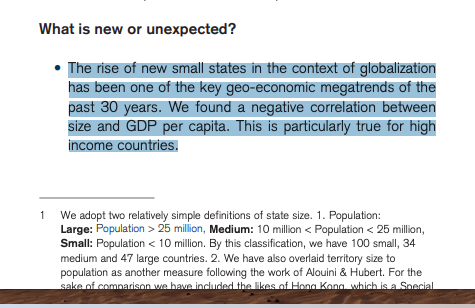This analysis reflects on conjectures regarding the performance of small and large countries in the last three decades, from 1984 to 2014 by Credit Suisse, while considering how these might hold up in the future, until 2023. Drawing from the performances and characteristics of select countries, patterns in the economies of scale can be discerned.

Size Matters: The Cut Off for Small Countries
Studied small countries, such as Singapore, Hong Kong, Norway, Estonia, Dubai, Switzerland, and Israel, all fall under the 10 million population bracket. The dynamics of these countries' public service show that a lean populace does not necessarily offset financial efficiency. They pay less tax both individually and corporate, while receiving the same benefits.
The Slippery Slope of Scale Economies: The Case of Japan, Germany, France, and the US
Large countries like Japan, Germany, and France with pouplations of over 50m once enjoyed a favorable scale economy. However, their status was overshadowed by the US, albeit with inconsistencies in medical costs and lifespan figures. The US's primary advantage of scale is an exemplary market capacity, impacting stock prices positively.
The Mediocre Middle: Countries with 10M-100M Populations
Countries like Canada and Netherlands, with populations ranging from 10 to 40 million, struggle to standout legally and to cultivate talent pools for emerging industries. They experience noticeable policy issues, creating an environment that seems lacking.
The Small State Success Story: Reflecting on Canada’s Past
Looking back to the pre-1980s, Canada was a small state success story, presenting an ideal alternative to the US. Such policy included universal health introduced in 1966. However, shifts in policy direction evident from unlimited immigration policy towards a more American model seem to have caused Canada to lose its footing. Legalization of marijuawana taken from a smaller state Nehterlands seems not to be in under control with the population size of over 40 million. That's observed in the historically high opioid related death recorded in 2022.
Replicating the Swiss Model: The European Context
It’s plausible that some large European countries have tried to adopt the Swiss model. However, their extensive diversity and tangled social cohesion may be too much to overcome in the following decades.
The Turn of the Tide: Japan's Learning Curve
Japan's recent interest in adopting elements from Singapore and maybe Taiwan signifies a shift in strategies from large countries, which will likely pick up pace in the 2020s. The new IR development has been modeled after Singapore as well as the recent visit by the Minister to learn from Singaporian digital governence.
The Rise of the Gulf: Dubai as an Exemplar
Dubai's economic development model seems to be increasingly influential among other Gulf countries. The Kingdom of Saudi Arabia with its Vision 2030 is well-positioned to carry this success forward.
The Impending Slowdown: The South Korean Paradox
Despite being on par with Japan and Western Europe in terms of GDP per capita, South Korea's growth pattern appears unsustainable. Their focus on economies of scale and low-cost models might prove challenging moving forward. They'd need some adjustment.
US Face Challenge
The success story of US is the scaling up of UK's legal tradition, governance, and academic success. US had much larger lands and resources and population quickly grew to 6 times larger that of UK after 2 centuries.
But US is facing a challenge from China, another large country with an even larger population (4 times that of USA).
Other large population candidates include Indonesia, Brazil, and India. They'll fight for scale against US.
For medium size countries namely the other developed countries, the future success lie in their abilities to adopt and scale the small city state models.

